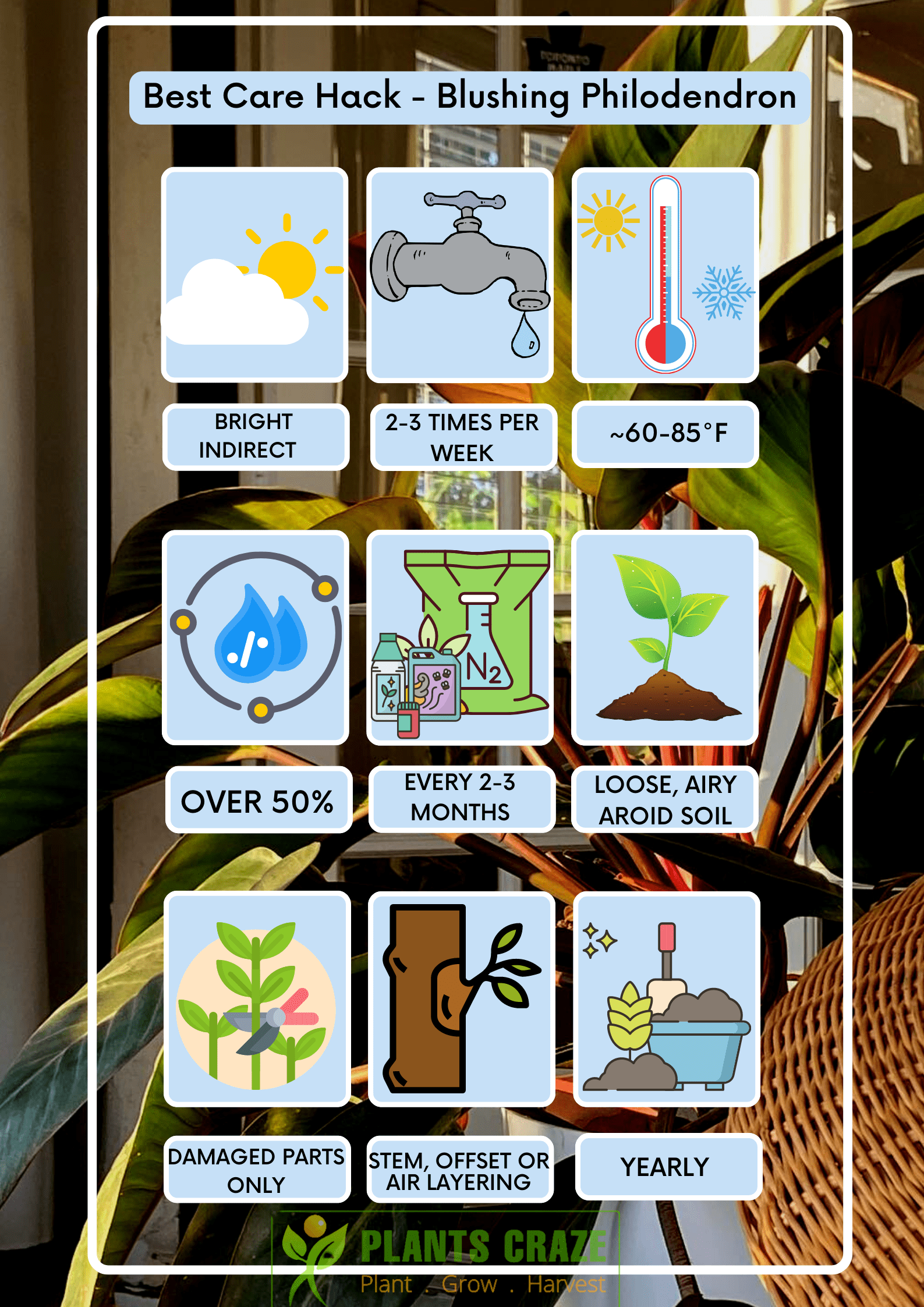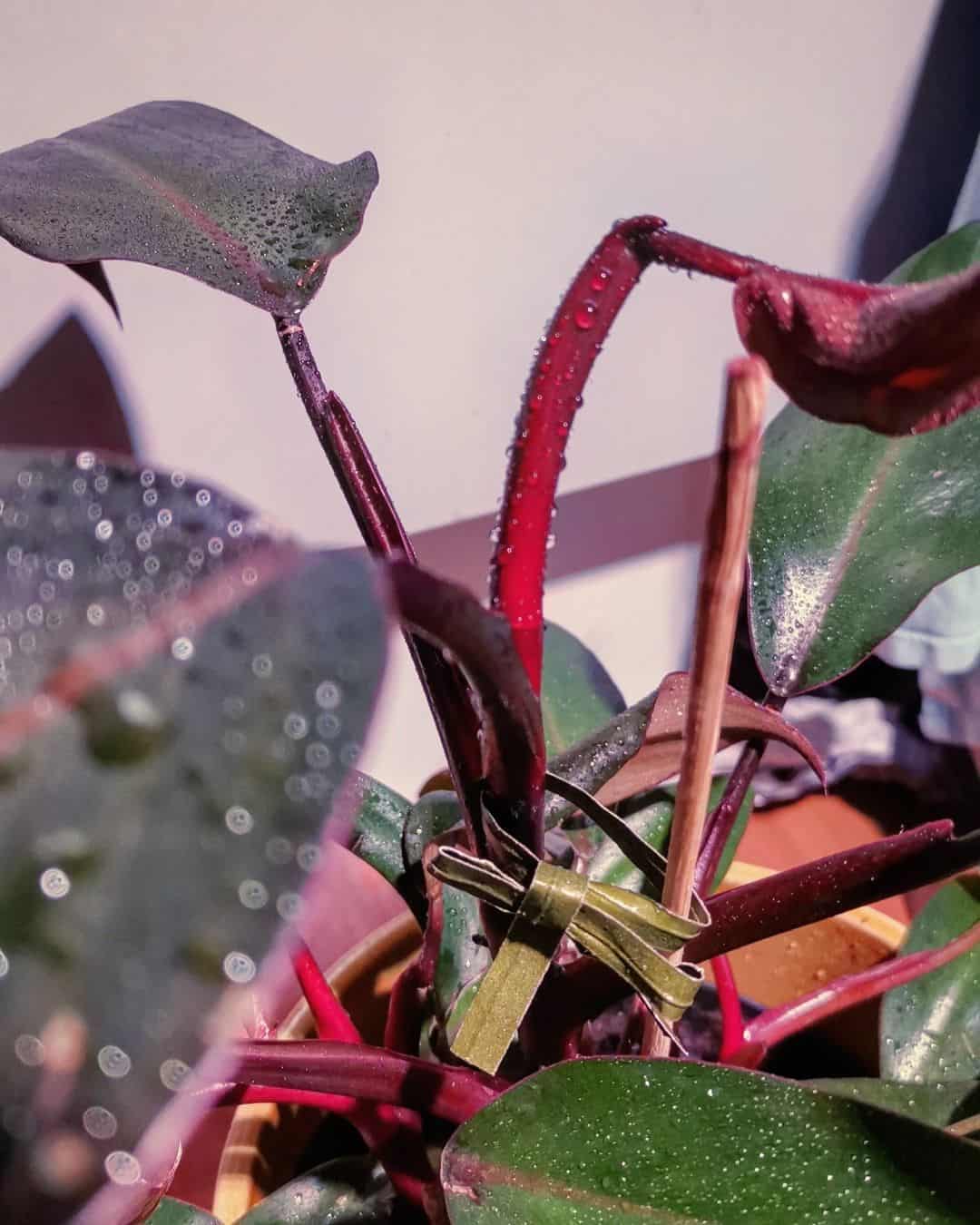Blushing Philodendron is an excellent climber with a beautiful wine-red tinted blush that fades away with an ignorant care routine.
Table of Contents Show
Overview of Blushing Philodendron
Blushing or red leaf Philodendron is a tropical flowering species belonging to Araceae.
They hail their exotic foliage from rainforests of Central and Southern America.
| Indicator | Identity |
|---|---|
| Scientific name | Philodendron erubescens |
| Common name | Blushing Philodendron, Red Leaf |
| Growth zone | Zones 10-12 |
| Growth Rate | Moderately fast |
| Growth Size | 24-36 inches |
| Foliage | Waxy dark green on top and red-purple at the bottom |
| Maturity | Five years to fully mature and flower |
| Blossom | Typical Philodendron flower after maturing |
| Flowering season | Summer and Autumn |
| Mature size | 2.5m-6m in height and 50cm-1m in spread |
| Toxicity | Toxic to pets and humans |
Philodendron Blushing: Best Care Hacks
Let us dive in for an in-depth care routine to bring out their best.

1. Sunlight & Temperature
The Blushing Philodendron prefers to stay in a well-lit room with a warmth of about 60-85°F.
Do not keep them close to the windows as exposure to cold drafts and temperatures below 50°F result in leggy, sparse, or no foliage growth.
In such peril, use artificial grow light that provides heat and light to keep them warm and happy.

Meanwhile, Blushing Philodendron withstands temperatures up to 100°F.
But do not let it rise beyond that, as it will dehydrate the plant from rapid transpiration.
2. Watering & Humidity
Blushing Philodendron is a drought-tolerant tropical plant that prefers humidity over 50%.
As Red Leaf is susceptible to overwatering, ensure the top inch of soil is dry before watering and avoid overhead watering.
Root rot, yellow leaves, molds, and foul smell coming from the soil are signs of overwatering.
It also attracts pests and fungal problems like excess humidity does. While wilted and brown leaves indicate underwatering.
Thus, saucer watering with pebbles is the best way to hydrate the plant in optimal humidity.
3. Soil & Fertilization
Red Leaf grows efficiently when you provide ideal soil with balanced nutrients.
And being heavy feeders, they need monthly 20-20-20 liquid fertilizers fertilization after dilution.
But beware of overfertilization in winter as dormancy hits them hard. So, fertilize them only once in 2-3 months in winter.
Generally, salt build-ups, root burn, brown curling leaf tips, and drooping leaves are signs of excess fertilizer.
Whereas stunted, sparse growth and fading yellow leaf color are signs of under-fertilization and compact soil.
You can prepare an ideal soil mix for your plant using peat, perlite, and sphagnum moss. Otherwise, you can choose African violet, orchid, or succulent soil mix.
4. Potting & Repotting
Blushing Philodendron is a tolerant plant that stays humble in a terracotta pot for almost a year.
Terracotta or ceramic pots with drain holes effectively avoids overwatering issues.
So, use such pots at least 2 inches wider than the plant’s root ball. You must also consider a bigger pot when repotting than the previous one.
Other telltale signs of the pot-bound plant are droopy, yellow leaves with no new growth.
Repot your Blushing Philodendron in early spring or summer to encourage vigorous growth.
You must thoroughly water your plant a day before repotting and use a fresh potting mix to repot.
5. Occasional Pruning
Although it is uncommon for Philodendrons to attract pests, mealy bugs, spider mites, and aphids trouble them occasionally.
Besides that, Blushing Philodendron isn’t impervious to bacterial blight, a highly contagious fungal disease.
Dark spots on leaves that spread like wildfire up to the petioles are the major sign of bacterial blight.
Here, the only way to control them is via pruning off infected leaves and repot them using a fresh mix.
Wet leaves and petioles from overhead watering often trigger bacterial blight.
You can apply neem oil and cleanse the leaves with soapy water to prevent pests and fungal diseases.
Meanwhile, if you are cutting healthy stems to keep plants in shape, use them for propagation.
Blushing Philodendron: All About Growth Rate
The Blushing Philodendron (Philodendron erubescens) is a flowering perennial with a climbing growth habit.
They are known for a moderately faster growth rate with vines that can spread up to 3-4 inches weekly.
It proliferates during summer and spring but remains dormant during the winter.
Their leaves are heart-shaped with the slightest red hue in the juvenile stage. However, as the plant matures (~5 years), the leaves’ color turns dark green.

In addition to its exotic foliage, stems also look red to purple.
After maturation, the plant blooms with red spathes of approximately 15 cm long with no fragrance in spring or summer.
Each plant can bear two to three flowering spathes that last for two days.
Toxicity of Blushing Philodendron
The Blushing Philodendron does not pose any threat until you or your pets take a bite out of it.
Blushing Philodendron contains insoluble calcium oxalate crystals all over their body parts.
Accidental ingestion can cause minor symptoms like mouth and bowel tract swelling, diarrhea, and vomiting.
Similarly, pets may lose appetite, hyper salivate, vomit, and paw frequently due to a burning sensation in the mouth.
Consumption of Blushing Philodendron in large portions can cause upper airway swelling, making breathing difficult for them.
Here are a few hotlines to seek medical help for Philodendron Poisoning.
- Animal Poison Control Center, ASPCA : (888) 426-4435
- Poison Control : (800) 222-1222
Propagation Method for Blushing Philodendron
Blushing Philodendron plant can be propagated via stem cuttings, offset division, and air layering.
Before you jump into propagation steps, ensure you have rooting hormones, shears, fresh potting mix, and suitable pots.
1. The Stem Cutting Method
Find yourself a healthy stem with at least two leaf nodes and cut it, leaving it 3-7 inches long.
- Partially deep the cut stem in a jar filled with water and rooting hormone.
- Look out for new root growths while placing in bright shade, which can take 1-2 months.
- Transplant the stems once they have inch-long root growths to a pot with fresh soil mix.
- And proceed to provide them with regular Blushing Philodendron care.
To do so, leave out pair of leaves above the soil. And ensure to place the pot in a humid room with 68° to 80°F temperature.
Propagated stems are most likely to develop roots within 20 to 25 days. You can transplant them to bigger pots after they can handle transplantation.
2. Offset Division
Once the offsets around the plant grow up to 4-5 inches tall, you can use them to propagate your plant.
Aim to divide offsets early spring for optimal growth and successful propagation.
- Carefully take out the offsets that have grown aerial or firm ground roots.
- Transplant individual offsets in the pot filled with fresh soil mix and nitrogen fertilizer.
- Place offsets 20 cm apart in a bright but indirectly lit room.
3. Air layering
Among all propagation methods, it is a tad bit more advanced. If you are unsure of air layering, proceed with stem cutting.
- Wrap a healthy node with a damp cloth or misted sphagnum moss.
- Use the cling wrap with some holes to ensure optimal humidity.
- Wait a few days for new root growths from the node.
- Carefully cut off the stem with roots and plant them in nutrient-rich soil.
Where to buy Blushing Philodendron?
Unlike the expensive Pink Princess, a perfect doppelganger, the price of Blushing Philodendrons is low and easy to find.
Here are a few online vendors with Blushing Philodendron for sale.
| Sites | Delivery |
|---|---|
| Plantly | Ships within a week |
| PeppyFlora | Ships within a 3 business days |
| Late Bloom | Ships within 5-7 days |
| Ecuagenera | Ships within a week |
Pink Princess Vs. Blushing Philodendron
Although Pink Princess Philodendron is also popular with the name Blushing Philodendron, they are different.
Pink Princess is a mutation form of Blushing Philodendron with bright pink variegation in its leaves.
| Features | Pink Princess Philodendron | Blushing Philodendron |
|---|---|---|
| Leaf | 8" long and 5" wide heart-shaped leaves. | Up to 16" long heart shaped leaves |
| Growth Rate | Slower | Faster |
| Root Growth in Water | Within 4 to 6 weeks | Within 2 to 3 weeks |
| Stem | Burgundy stems | Red stems |
From Editorial Team
Conclusion!
Beetle pollination is more common in Philodendrons, as it produces the pheromones which attract male beetles.
Moreover, don’t let your Philodendron leaves be covered with dust.
Dust blemishes the appearance and promotes pests and pathogen invasion.


